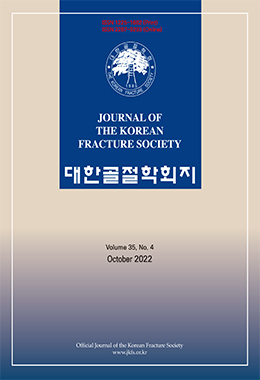목적: PFNA-II의 단점을 보완한 TFNA를 대퇴 전자간 골절에 적용하여 PFNA-II와 임상적 및 방사선학적 결과를 비교하였다.
대상 및 방법: PFNA-II 혹은 TFNA로 수술 받은 82명을 분석하였으며, 최소 1년 이상 추시가 가능했던 경우만 연구에 포함하였다. 방사선학적 결과 비교를 위해서 두 군의 골유합 여부, 경부의 단축 정도를 분석하였으며, 임상적으로는 재수술이 필요한 합병증의 빈도를 분석하였고, Koval score를 이용하여 수술 전후의 보행 기능을 평가하였다.
결과: PFNA-II 환자군에서 평균 추시기간은 22개월이었고, TFNA 환자군에서는 19개월이었다. 합병증은 PFNA-II군에서 대퇴 천공 2건, 내반 붕괴 1건으로 TFNA군의 대퇴 천공 1건보다 높은 모습을 보였으나, 통계적 유의성은 없었다(p=0.37). 또한 대퇴 경부의 단축 정도, 수술 후 보행기능의 감소 정도에서 TFNA군이 PFNA-II군보다 우수한 경향성을 보였으나 두 군 간 통계적 유의성은 없었다.
결론: TFNA와 PFNA-II 모두 양호한 결과를 보이며, 보행능력의 회복과 합병증 발생 빈도 및 대퇴 경부 단축 정도 측면에서 유의한 차이를 보이지 않아 두 기구 모두 대퇴골 전자간부 골절의 치료에 적절한 선택으로 판단된다.
Purpose: Trochanteric fixation nail advanced (TFNA) was modified to compensate for the shortcomings of proximal femoral nail antirotation-II (PFNA-II). The clinical and radiological outcomes of surgeries using the PFNA-II and TFNA for femoral intertrochanteric fractures were compared.
Materials and Methods: Eighty-two patients who underwent surgeries using PFNA-II or TFNA were analyzed. Only those who were followed up for more than a year were enrolled. Bone union, shortening of the femoral neck, and the tip-apex distance of the intramedullary nail were compared in the radiological findings. Clinical outcomes, including the frequency of complications and gait ability (Koval score), were also assessed.
Results: The mean follow-up periods were 22 and 19 months for the PFNA-II and TFNA groups, respectively. In the PFNA-II group, two cases of femoral head cut-out and one case of varus collapse were observed. In the TFNA group, only one case of femoral head cut-out was observed; however, there was no significant difference in the frequency of complications between the two groups (p=0.37). Additionally, both the shortening of the femoral neck and the decrease in gait ability after surgery showed relative improvement in the TFNA group compared to the PFNA-II group; however, there was no significant difference between the two groups.
Conclusion: The use of both TFNA and PFNA-II was associated with satisfactory outcomes. In patients who underwent surgeries using TFNA, the recovery of gait ability, frequency of complications, and shortening of the femoral neck were not significantly different from PFNA-II, suggesting that both are suitable instrument choices for intertrochanteric fracture treatment. However, the clinical significance must be further assessed using a larger group of patients over a longer follow-up period in future studies.


